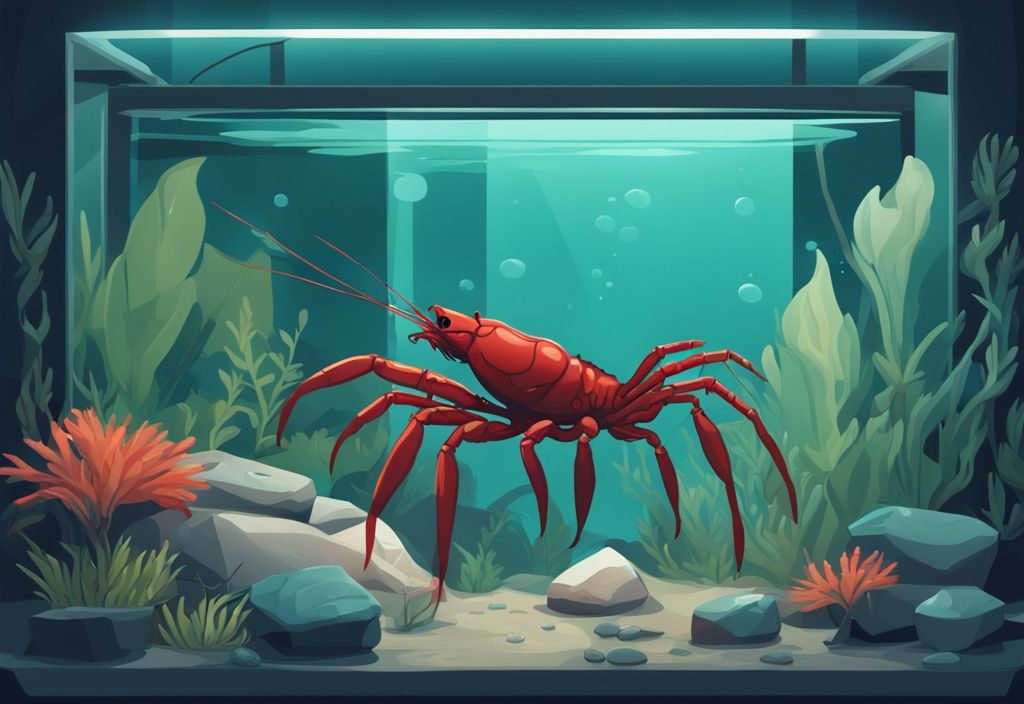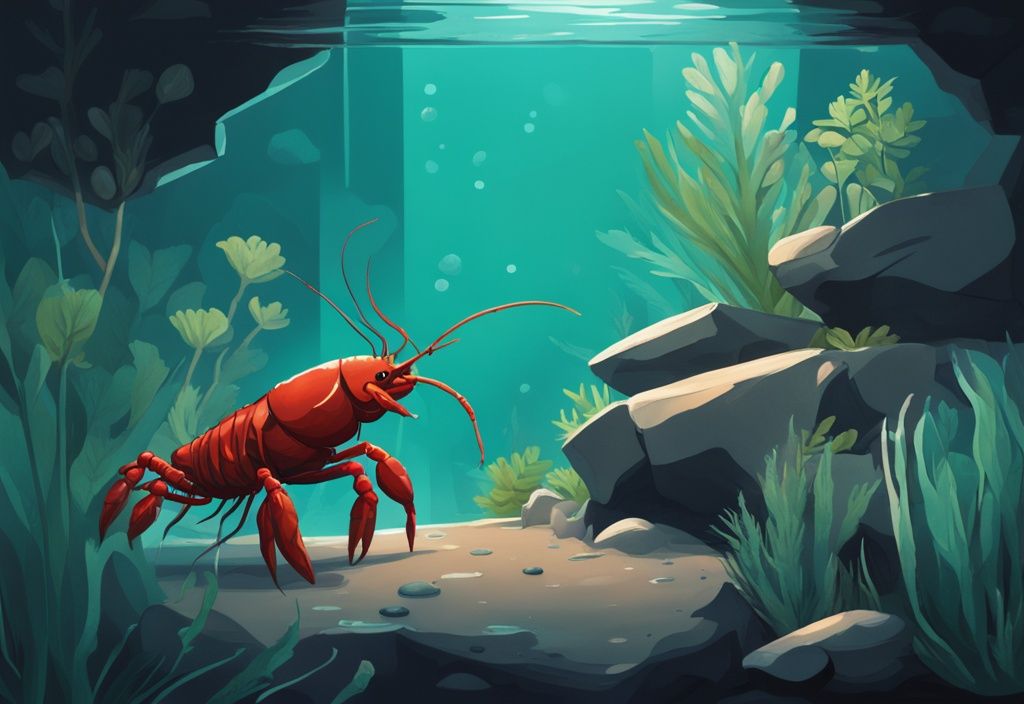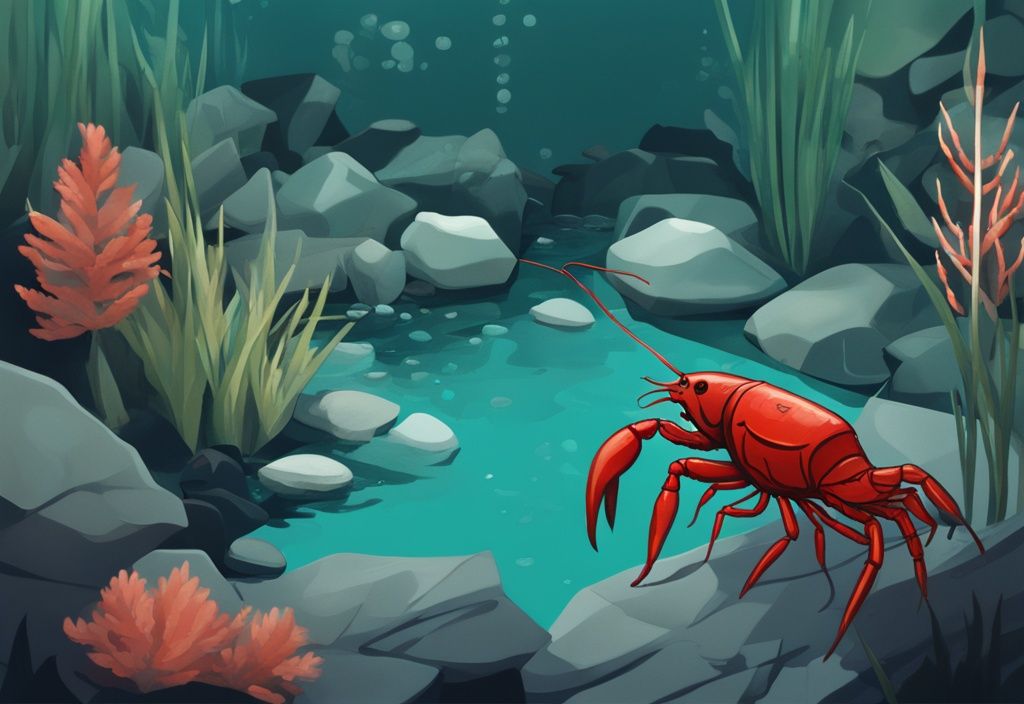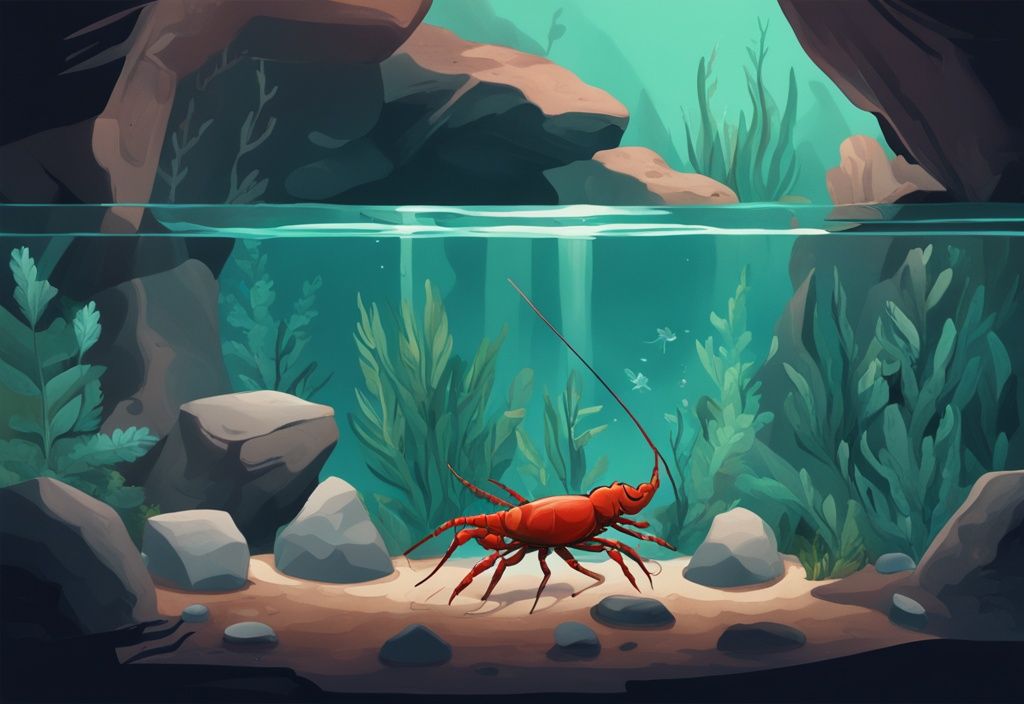Setting up a crayfish tank is an exciting venture that offers both a rewarding hobby and a stunning visual addition to any space. Crayfish, with their vibrant colors and intriguing behaviors, are a unique choice for aquarists seeking something beyond the typical fish tank. However, their specific needs require careful consideration and planning, making their tank setup distinct from other aquatic pets.
Crayfish are known for their adventurous nature and require a habitat that caters to their exploratory instincts. This guide will walk you through every step of creating a thriving environment, from choosing the right tank and location to ensuring optimal water quality and selecting compatible tank mates. Each section is designed to simplify the process, providing you with the knowledge to maintain a healthy and aesthetically pleasing crayfish tank.
A well-set crayfish tank not only ensures the health and longevity of your aquatic companions but also enhances the beauty of your home or office. As you dive into this comprehensive guide, you’ll discover the joy of watching your crayfish thrive in an environment tailored to their needs. Prepare to embark on a journey that combines creativity, science, and a touch of nature’s wonder.
Choosing the Perfect Tank for Your Crayfish
Selecting the right tank for your crayfish is essential to ensure a thriving environment. From size to material, each choice plays a vital role in creating a balanced ecosystem that supports your crayfish’s natural behavior and well-being.
Recommended Tank Size
When setting up a crayfish tank, selecting the appropriate size is crucial for the well-being of your aquatic pet. A minimum tank size of 20 gallons is recommended for a single crayfish. This size provides enough space for the crayfish to explore and establish its territory. If you plan to keep multiple crayfish, opting for a larger tank is essential. A spacious environment helps reduce aggression among crayfish and ensures they have ample space to move around comfortably.
Material: Glass vs. Acrylic
Choosing between glass and acrylic tanks is a common consideration for crayfish enthusiasts. Both materials offer durability, making them suitable for housing crayfish. Glass tanks are popular for their clarity and resistance to scratching, while acrylic tanks are lighter and less prone to breaking. Importantly, crayfish cannot climb the smooth surfaces of either glass or acrylic, minimizing the risk of escape. This feature makes both materials excellent choices for a secure crayfish habitat.
Why You Need a Secure Lid
Crayfish are notorious escape artists, capable of climbing and maneuvering their way out of tanks. Therefore, a secure lid is an essential component of any crayfish tank setup. A well-fitted lid not only prevents crayfish from escaping but also keeps external contaminants out of the tank. This added layer of protection ensures a safe and controlled environment for your crayfish, reducing the likelihood of accidents and maintaining the integrity of the tank ecosystem.
Where to Place Your Crayfish Tank
Creating the perfect environment for your crayfish starts with choosing the right location for the tank. This involves considering factors like sunlight exposure and the stability of the tank’s placement. Each element plays a critical role in ensuring your crayfish thrive in a balanced ecosystem.
Avoiding Direct Sunlight
Positioning your crayfish tank correctly is crucial for maintaining a healthy environment. One of the primary considerations is to avoid placing the tank in direct sunlight. Imagine your tank as a delicate balance of life, where too much sunlight can tip the scales. If you’re dealing with unwanted guests, you might want to learn how to get rid of snails in aquarium to maintain this balance. It leads to excessive algae growth, turning your tank into an unsightly green mess that demands frequent cleaning. Moreover, sunlight can cause temperature swings that are as unpredictable as a roller coaster ride, stressing your crayfish. These little creatures are like us—they love stability. By choosing a spot away from windows or other sources of direct sunlight, you ensure a more controlled and consistent habitat for your aquatic friend.
Ensuring Stability and Accessibility
Think of your crayfish tank as a small fortress. It needs a solid foundation to prevent any risk of tipping or accidental spills. A sturdy stand or table, designed specifically for aquariums, is your best bet. It supports the weight of the tank when filled with water and decorations. But stability is only part of the story. Accessibility is equally important. You want to be able to reach into the tank easily for regular maintenance and feeding. Imagine trying to clean or feed your crayfish if the tank is tucked away in a hard-to-reach corner. Prioritizing stability and accessibility creates a safer and more manageable environment for both you and your crayfish.
Creating the Ideal Tank Environment
Setting up a crayfish tank is an art that balances aesthetics with functionality. The right environment ensures your crayfish thrive, engaging naturally with their surroundings. Below, you’ll find insights on substrate choice, designing hiding spots, and incorporating aquatic plants to create a harmonious habitat.
Substrate Selection: Gravel vs. Sand
Choosing the right substrate is pivotal in crafting a successful crayfish tank setup. Imagine your crayfish as little architects, constantly digging and burrowing. Fine gravel or sand allows them to indulge in this natural behavior, promoting both mental stimulation and physical health.
Ensure the substrate is easy to clean and free from sharp edges to prevent injuries. Think of it as laying a soft carpet that invites exploration. It should also be deep enough to allow for burrowing, a comforting activity for your crayfish.
Designing Hiding Spots and Decorations
Creating a secure and enriching environment for your crayfish involves designing plenty of hiding spots within the tank. Utilize aquarium rocks, driftwood, and PVC pipes to construct these shelters. Hiding spots are essential as they help crayfish feel secure, reducing stress and territorial aggression. These structures also mimic the crayfish’s natural habitat, providing them with a sense of familiarity and safety. When arranging decorations, ensure they are stable and do not pose any risk of falling or injuring the crayfish.
Adding Hardy Aquatic Plants
Incorporating hardy aquatic plants into your crayfish tank setup not only enhances the aesthetic appeal but also contributes to a balanced ecosystem. Opt for resilient plants such as Java Fern, Anubias, Vallisneria, and Java Moss, which can withstand occasional nibbling or uprooting by crayfish. These plants provide additional hiding spots and help in maintaining water quality by absorbing nitrates. When planting, ensure they are securely anchored to prevent uprooting and to allow crayfish to explore and interact with their environment naturally.

Ensuring Water Quality and Filtration
Creating a thriving crayfish tank setup hinges on maintaining pristine water quality. This involves selecting the right filtration system and keeping water parameters in check. These elements work hand in hand to foster a balanced ecosystem where crayfish can flourish.
Choosing the Right Filtration System
Imagine your crayfish tank as a bustling city, with the filtration system acting as its diligent sanitation crew. A well-chosen filter is key to managing waste and maintaining water clarity. Opt for a hang-on-back or canister filter; both are adept at handling the biological load. They efficiently remove debris and harmful substances, ensuring a stable environment for your crayfish.
Remember, even the best filters need regular check-ups. Think of it as a spa day for your filter—cleaning it prevents waste buildup and keeps it in top shape. This simple routine can make all the difference in preserving water quality. For tips on maintaining optimal water conditions, including how to lower GH in aquarium, explore our detailed guide.
Maintaining Water Parameters
Crayfish are like the Goldilocks of the aquatic world—they need conditions that are just right. They thrive in slightly alkaline water, with a pH level between 7.0 and 8.0. Regularly testing the water is crucial to avoid stressful fluctuations that could lead to health issues.
Temperature is another critical factor. Keep the water between 65°F and 75°F (18°C–24°C). A reliable aquarium heater or cooler can help maintain this range. Crayfish, much like us, dislike sudden temperature changes. Consistent monitoring and gentle adjustments will create a comfortable and safe habitat for your aquatic friends.
By focusing on these elements, you not only enhance the well-being of your crayfish but also contribute to a sustainable and balanced aquarium ecosystem.
Providing Oxygenation for Your Crayfish
Ensuring proper oxygenation in your crayfish tank is crucial for the health and well-being of your aquatic pets. Crayfish, like all aquatic creatures, require a sufficient supply of oxygen to thrive. Without it, they can become stressed or even drown. To prevent this, incorporating air bubblers or bubble walls into your crayfish tank setup is essential.
Imagine your crayfish tank as a bustling underwater city. Just like city dwellers need fresh air, your crayfish need well-oxygenated water. Air bubblers and bubble walls are the unsung heroes here, enhancing water circulation and boosting oxygen levels. By creating a steady stream of bubbles, these devices help to agitate the water surface, facilitating gas exchange. This process allows oxygen to dissolve into the water while expelling carbon dioxide, ensuring a healthy environment for your crayfish.
When choosing an air bubbler or bubble wall, consider the size of your tank and the specific needs of your crayfish. A larger tank may require multiple bubblers or a more powerful bubble wall to adequately oxygenate the water. Additionally, ensure that the equipment is compatible with your tank’s filtration system to maintain optimal water quality.
Positioning the air bubbler or bubble wall correctly is also important. Place it in an area where it can effectively circulate the water without causing excessive currents that might disturb the crayfish or other tank inhabitants. Regularly check the equipment to ensure it is functioning properly and clean it as needed to prevent blockages.
By prioritizing oxygenation in your crayfish tank setup, you create a stable and healthy environment that supports the natural behaviors and longevity of your crayfish.
Feeding Your Crayfish: What and When
Understanding the dietary needs and feeding schedule of your crayfish is essential for creating a thriving tank environment. This section covers their nutritional requirements and how to establish a consistent feeding routine.
Dietary Requirements
Crayfish are intriguing omnivores with a penchant for diverse diets, which are crucial for their health and vibrancy. To cater to their nutritional needs, offer a blend of plant matter, algae wafers, and sinking pellets. These staples provide essential nutrients and mirror their natural foraging habits.
Additionally, supplement their diet with protein-rich foods like bloodworms or shrimp. This satisfies their carnivorous cravings and supports their growth and shell development. A balanced diet is key to maintaining your crayfish’s overall well-being, encouraging active behavior and vibrant coloration.

Feeding Schedule and Tips
Setting a consistent feeding schedule is vital for your crayfish’s health. Aim to feed them three to four times a week, ensuring they consume their meals within a few hours. This frequency provides adequate nutrition without overfeeding, which can lead to water quality issues.
After feeding, promptly remove any uneaten food to prevent decomposition and maintain the tank’s water parameters. Monitoring your crayfish’s eating habits helps you adjust portion sizes and keep a clean, healthy environment. By sticking to a regular feeding routine, you ensure your crayfish stay active and healthy in their aquatic home.
Choosing Compatible Tank Mates
When setting up a crayfish tank, selecting the right companions is vital for maintaining a peaceful aquatic environment. The following sections will guide you through choosing both fish and other aquatic creatures that can coexist harmoniously with crayfish.
Fish Species to Consider
Selecting fish that can thrive alongside crayfish requires a bit of strategy. Picture a bustling underwater community where speed and resilience are your best allies. Fast and hardy fish species, like Zebra Danios, Rosy Barbs, Guppies, Tiger Barbs, and Mollies, fit this bill perfectly. Think of them as the marathon runners of the fish world—quick on their fins and tough enough to handle the occasional crayfish curiosity. Their agility helps them dodge any unwanted attention, creating a dynamic yet peaceful tank setup.
Other Aquatic Companions
Beyond fish, consider adding other aquatic creatures that can complement your crayfish tank setup. Amano Shrimp and Nerite Snails are excellent choices. These little helpers not only steer clear of crayfish territorial instincts but also play a crucial role in maintaining the tank’s cleanliness by managing algae and detritus. Imagine them as the diligent janitors of your aquatic world. However, be cautious about introducing small or slow-moving fish, as they might not fare well against the crayfish’s natural tendencies. By thoughtfully selecting tank mates, you can cultivate a balanced and vibrant ecosystem that minimizes conflicts and enhances the overall health of your aquatic community.
Monitoring and Maintaining Tank Health
Creating a thriving crayfish tank setup requires diligent monitoring and maintenance. This involves regular water changes and cleaning practices to ensure a balanced and healthy aquatic environment. Let’s dive into the essential steps for maintaining your tank’s health.
Regular Water Changes
Maintaining optimal water quality is the cornerstone of a healthy crayfish tank setup. Think of it like giving your aquarium a refreshing breath of fresh air. Aim to perform a 20-25% water change weekly. This routine helps in removing accumulated toxins and waste products, ensuring a cleaner environment for your crayfish.
During water changes, don’t forget to clean the substrate thoroughly. Imagine it as tidying up the floor of your crayfish’s home. This involves removing uneaten food and waste, which can otherwise lead to harmful ammonia and nitrate buildup. A clean substrate not only contributes to better water quality but also promotes the overall health of your aquatic ecosystem.
Cleaning and Maintenance Tips
To keep your crayfish tank setup in top condition, regular cleaning and maintenance of the filtration system are imperative. A well-functioning filter is like the lungs of your tank, crucial for handling crayfish waste and preventing water quality issues. Check and clean the filter routinely to maintain its efficiency in removing debris and maintaining water clarity.
Additionally, monitoring water parameters with aquarium test kits is essential. Regular testing allows you to keep track of pH levels, ammonia, nitrites, and nitrates, ensuring they remain within safe ranges. By staying vigilant with these maintenance practices, you can create a stable and healthy environment for your crayfish. Remember, a little effort goes a long way in fostering a vibrant and balanced aquatic ecosystem.
Identifying and Preventing Crayfish Diseases
Understanding how to identify and prevent common crayfish diseases is crucial for maintaining a healthy crayfish tank setup. This section delves into two prevalent conditions—shell rot and white spot disease—offering practical advice to keep your crayfish thriving.
Spotting Shell Rot
Shell rot, much like a pesky rust on a car, can sneak up on your crayfish if you’re not vigilant. Regular check-ups are your best defense. Imagine it as a routine health check for your aquatic buddy. Look for any discoloration or lesions on their shell—these are the telltale signs of shell rot.
Maintaining a pristine tank environment is your frontline defense. Think of it as keeping your home clean to ward off colds. Regular water changes and a reliable filtration system are your best allies here. And don’t forget about nutrition! A balanced diet rich in essential nutrients acts like a multivitamin for your crayfish, boosting their immune system and keeping shell rot at bay.

Preventing White Spot Disease
White spot disease, or Ich, is like the common cold of the crayfish world. It shows up as small white spots on their body and might bring along some unusual behavior—think lethargy or erratic movements.
To keep this ailment at arm’s length, keep a close eye on your crayfish for any signs of distress. Quarantining new crayfish before introducing them to your established tank is akin to washing your hands during flu season. This practice helps catch any potential pathogens before they can spread to other tank inhabitants.
By being vigilant and sticking to quarantine protocols, you’re not just preventing white spot disease—you’re safeguarding the entire ecosystem of your tank.
Conclusion
Setting up a crayfish tank is a delightful journey into the world of aquatic life, requiring a few key steps to create a thriving environment for these intriguing creatures. Begin with selecting the right tank size; a minimum of 20 gallons is ideal for a single crayfish, offering enough space to minimize aggression if you plan to house more than one. Both glass and acrylic tanks are excellent choices, as their smooth surfaces deter escape attempts by these crafty critters. Don’t forget a secure lid—crayfish are notorious escape artists!
Where you place your tank matters too. Avoid direct sunlight to prevent unwanted algae blooms and temperature swings that could stress your crayfish. Ensure the tank sits on a stable surface, making maintenance and feeding a breeze. For the substrate, think of fine gravel or sand—perfect for digging and burrowing. Add some rocks, driftwood, and PVC pipes as hiding spots to reduce territorial disputes and provide a sense of security.
Water quality is the backbone of a healthy crayfish tank. A reliable filtration system is essential to manage waste and maintain water parameters, with a pH between 7.0 and 8.0 and a temperature range of 65°F to 75°F (18°C–24°C). Oxygenation is crucial, so consider air bubblers or bubble walls to keep your crayfish from drowning.
Feeding is another vital aspect. A varied diet of plant matter, algae wafers, and protein-rich foods will keep your crayfish healthy. Aim to feed them 3-4 times a week, and remember to remove any uneaten food to maintain water quality. When choosing tank mates, go for fast and hardy fish like Zebra Danios and Rosy Barbs, which can peacefully coexist with crayfish.
Regular monitoring and maintenance are your best friends. Perform weekly water changes, clean the substrate, and check the filter regularly. Stay vigilant for signs of diseases like shell rot and white spot disease. Quarantine new crayfish before introducing them to the tank to prevent the spread of illness. By following these guidelines, you’ll create a balanced and sustainable ecosystem, ensuring your crayfish thrive in their aquatic home.
FAQ
Setting up a crayfish tank might seem daunting, but with the right guidance, it can be an enriching experience. Below, you’ll find answers to some common questions that will help you create a healthy and harmonious environment for your aquatic companions.
What size tank do I need for a crayfish?
Imagine your crayfish as a little explorer needing enough territory to roam. A single crayfish thrives in a tank of at least 20 gallons. If you’re considering a crayfish community, think bigger! A larger tank helps reduce territorial disputes and ensures everyone has room to breathe.
Can crayfish live with other fish?
Crayfish can indeed share their space with certain fish species. Consider fast and resilient swimmers like Zebra Danios, Rosy Barbs, and Mollies. These fish are quick enough to dodge any curious crayfish pinch. However, steer clear of slow or tiny fish, as they might end up on the menu.
How often should I feed my crayfish?
Feeding your crayfish is like setting a dinner schedule for a picky eater. Aim for 3-4 meals a week, offering a varied diet to keep them healthy and happy. Remember to clear away any leftovers to maintain pristine water conditions. Your crayfish will thank you!
What should I do if my crayfish escapes?
Crayfish are quite the escape artists! If yours decides to go on an adventure, first secure the tank lid. Then, search around the tank area. They can survive out of water for a limited time, so act swiftly to bring them back to their aquatic home.
